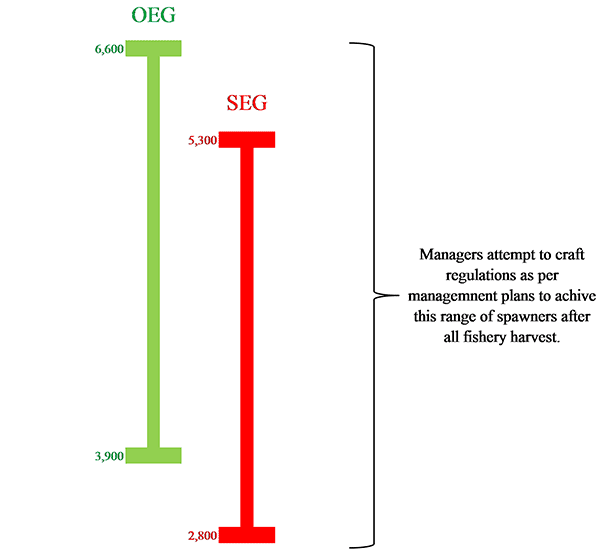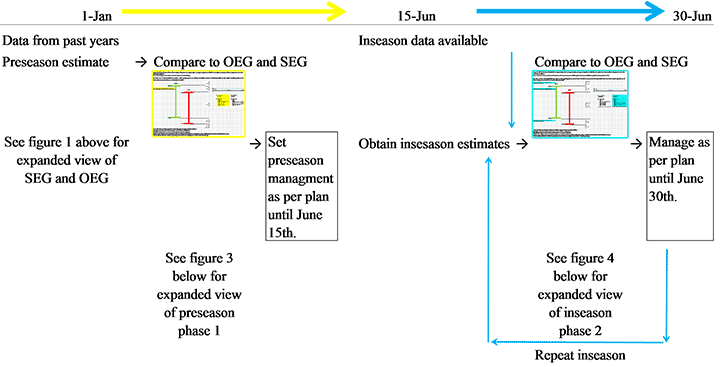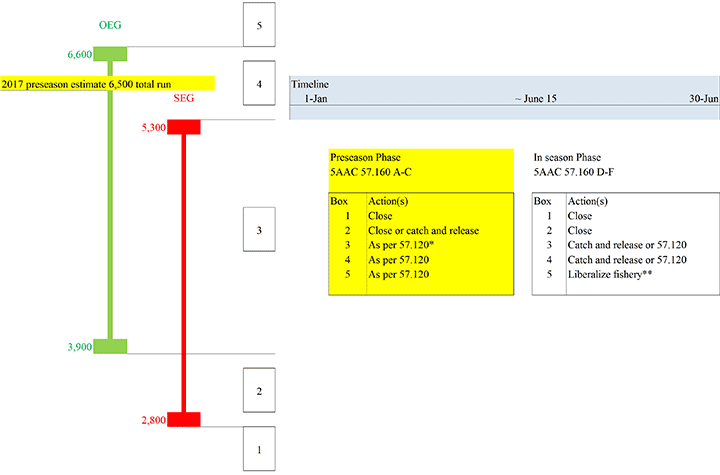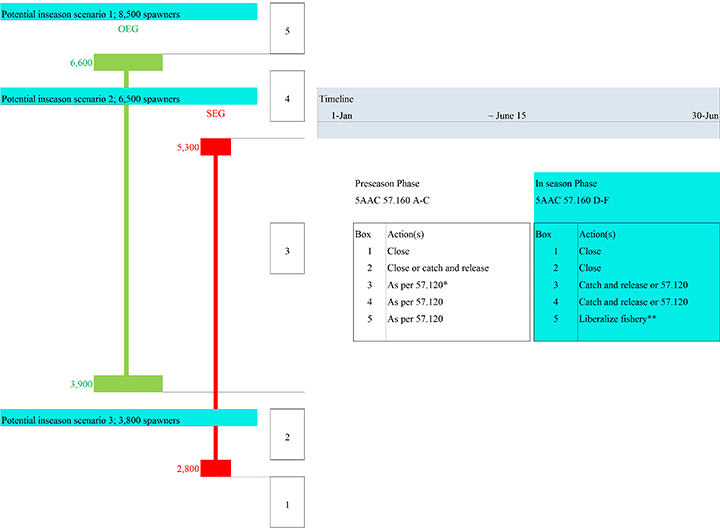Northern Kenai Peninsula Management Area
Fishing Management
Management
The Northern Kenai Peninsula Management Area includes all waters between Ingram Creek in the north and the Kasilof River in the south. The primary attractions to anglers in this area are the Kenai and Kasilof rivers, but many other lakes and streams can also be found. On the Kenai River, large fisheries exist for king, sockeye and coho salmon, as well as rainbow trout and Dolly Varden. Management plans and policies directed at these species guide fisheries managers in achieving sustainable fisheries.
The Alaska Department of Fish and Game (ADF&G) uses abundance based management to help ensure that fisheries are sustainable and fish populations are conserved for future generations. The primary tool in abundance based management on the Kenai River is a sustainable escapement goal (SEG). A sustainable escapement goal represents the number of spawning salmon that are required to sustain the fish population and fisheries across time. These goals are set as ranges. For example, the Kenai River early run king salmon SEG is for 2,800 to 5,300 large king salmon. Large king salmon over 34 inches are the focus of the escapement goal here because smaller king salmon are difficult to assess in the turbid Kenai River waters, and additionally small king salmon fluctuate in abundance dramatically in the Kenai River causing management uncertainty.
- Spawner-Recruit Analyses and Escapement Goal Recommendations for Kenai River Chinook Salmon (PDF 1,062 kB).
Guided by management plans and policies, fishery managers attempt to craft regulations that allow the spawning fish abundance of large king salmon to fall within the escapement goal range at the end of the year. As such, fishery regulations are set to allow harvest, but also so that sufficient numbers of fish are allowed to spawn. Across years, fishery managers also try to attain year end escapements that are spread throughout the goal range, i.e. some low in the range, some in the middle, and some high. This helps approximate natural variation in fish abundance and also helps maximize potential yield in fisheries. ADF&G determines sustainable escapement goals using biological information and routinely reviews these goals for accuracy.
- Northern Cook Inlet Escapement Goal Memo (PDF 900 kB).
In implementing abundance based management, fishery managers also follow fishery management plans in order to help achieve desired management goals. These plans are set in regulation by the Alaska Board of Fisheries (BOF) to allocate fish resources among users and manage fisheries in a predictable way. There are three primary fishery management plans for the Kenai River. (1) The Kenai River and Kasilof River Early Run King Salmon Management Plan; (2) the Kenai River Late Run King Salmon Management Plan; and (3) the Kenai River Late run Sockeye Salmon Management Plan. These plans set out priorities for managers to follow, and in some cases set management targets for the department to achieve. For example, a BOF management plan may also include an optimal escapement goal, typically higher than sustainable escapement goal, in order to increase in-river fish numbers as a desirable management outcome.
As the fish runs develop throughout the run, fishery managers predict run size, determine inseason run strength, set inseason regulations, and attempt to achieve the escapement goal(s) guided by fishery management plans. Fishery regulations are listed in our regional regulation summary booklets, which are available on the Sport Fishing Regulations webpage, or as hard copies at local vendors and ADF&G offices. Regulations may also be refined inseason by emergency order (EO) if inseason fish assessments indicate harvest pressure needs to be altered to ensure achievement of escapement goals and sustainability. Emergency orders can liberalize fishery methods in order to increase harvest as a result of above average spawning fish numbers, or they can restrict fisheries if spawning abundance is too low. EO changes are available on our Emergency Orders and News Releases webpage, are posted at vendors and ADF&G offices, or are also posted at major river access points. The regulatory text of all fishery management plans can be found at the Alaska Administrative Code website.
Both preseason analytical methods and inseason assessments are used to assess run strength. Preseason analytical methods are used to predict run size prior to each year. The preseason analyses utilize abundance counts of fish and harvest numbers to tally total fish abundance by age across time. This yearly age abundance data is used to model run survival and predict future run size before the fishery begins. Inseason fish abundance projects then produce data so that managers can determine actual run abundance each year and achieve escapement goals while following management plans. Sonar projects that count fish, creel projects that assess harvest, and netting projects that determine age of fish, are all examples of fishery projects used to produce inseason data for fishery management on the Kenai River. The results of these types of projects from the Kenai River, as well as those for other projects across the state are available on the ADF&G publication webpage. Data summaries and analyses used by fishery managers on the Kenai River are also available for public viewing at the Northern Kenai Peninsula Management Area webpage, and Kenai River fish counts as well as fish counts from other streams, can be found at the ADF&G fish count webpage.
As a specific example (see figures 1- 4 below) of how fisheries are managed on the Kenai Peninsula, below are the management steps for The Kenai River and Kasilof River Early Run King salmon Management plan (5AAC 57.160). This plan sets a regulatory structure for the early run king salmon sport fishery. The plan directs the department to use broad general regulations for king salmon management on the Kenai River (5AAC 57.120) at certain possible abundance scenarios, or it can also direct the department to specific management steps by EO at other abundance scenarios. Both preseason and inseason information is used as directed by this plan. The preseason information is used to set regulations prior at the beginning of the season before sport harvest begins. Inseason assessment information is then used during the fishery, to adjust regulations by emergency order if needed, based on actual spawning run abundance. Potential EO changes are spelled out in the management plan so that harvest pressure is directed to certain areas of the river (upstream or downstream of Slikok Creek in this case) and at certain sized fish. The BOF has chosen to direct harvest pressure in this way after consultation with community groups and expressed user preferences as regulatory meetings (see BOF webpage for more info). This plan governs management of the king salmon fishery until June 30 for "early run king salmon" that primarily spawn in tributary streams of the Kenai River.
Example Management steps for Kenai Early Run King Salmon Management
The sustainable escapement goal (SEG) for the Kenai River early run king salmon run is 2,800 to 5,300 (red in figure 1) large king salmon. The Kenai River and Kasilof River Early Run King salmon Management plan also includes and Optimal Escapement Goal (OEG) of 3,900 to 6,600 (green in figure 1) large king salmon,

Figure 1. Chart of OEG (in green) and SEG (in red) for Kenai River early run king salmon.
General flow of decisions; This Plan has two phases of management (figure 2), the preseason phase (in yellow) and the inseason phase (in blue) to achieve these goals.

Figure 2. Flow chart of decisions for King salmon management on the Kenai River.
Preseason Phase 1 specifics (figure 3)
Utilizing the preseason estimate in comparison to the SEG and OEG, regulations are set for the fishery at the beginning of the run. Five separate management boxes are possible (boxes 1-5 in figure 3) depending on how the preseason estimate compares to the SEG and OEG. Boxes 1-2 are restrictive based on a low preseason estimate and result in no harvest or total closure by emergency order. Boxes 3-5 are more liberal based on higher preseason estimates and allow more harvest potential via standard regulations (5AAC 57.120) for king salmon angling on the Kenai River. For this example, the preseason estimate is 6,500 (yellow in figure 3) large king salmon.
The fishery will be managed to start as per box 4 with standard regulations as found in 5AAC 57.120;
- Single hook and no bait from January 1 to June 30 below Skilak Lake.
- 1 fish per day and in possession over 20 inches but less than 34 inches.
- There is a 2 fish per year annual limit of fish over 28 inches. This limit is in combination with a 5 fish limit from other Cook Inlet Drainage waters.

Figure 3. Preseason-phase 1 decision chart.
Inseason Phase 2 specifics (figure 4)
Utilizing the inseason data, usually available by June 15th, in comparison to the SEG and OEG, regulations will be reevaluated for the fishery until June 30. Several possible scenarios (see below figure 4) may develop depending on inseason run size.
Five separate management boxes are possible (boxes 1-5 in figure 4) depending on how the inseason estimate compares to the SEG and OEG. Boxes 1-2 are restrictive based on a low inseason estimates and result in no harvest or total closure by emergency order. Boxes 3-4 are more liberal based on higher inseason estimates and allow more harvest potential via standard regulations (5AAC 57.120) for king salmon angling on the Kenai River. Box 5 would ease regulation by emergency order if the OEG is projected to be exceeded and allow more harvest. Emergency order liberalizations of the fishery can only occur downstream of Slikok Creek as per the plan.
- Possible Scenario 1; inseason data suggests spawning run escapement of 8,500 large fish. Manage as per box 5, Liberalize fishery by EO... Allow harvest of fish less than 44 inches, may also allow bait if 44+ in. fish catch rates are not high. Liberalization of fishery cannot occur above Slikok Creek.
- Possible Scenario 2; inseason data suggests spawning run escapement of 6,500 large fish. Manage as per box 4, no changes from earlier management via 5AAC 57.120.
- Possible Scenario 3; inseason data suggests spawning run escapement of 3,800 large fish, Manage as per box 2, close fishery by EO until run abundance improves or June 30.

Figure 4. Inseason-phase 2 decision chart.
The above inseason process of phase two is repeated weekly to reassess run abundance and management specifics until June 30. After June 30, The Kenai River Late Run King Salmon Management Plan begins. A similar methodology is used for the late run, but run abundance is higher for this population which unlike the early run, spawns in the river mainstem. The restriction to harvest liberalization above Slikok Creek remains throughout both the early and late run king salmon fisheries. Like the early run, no harvest of fish over 34 inches during the late run is allowed upstream of Slikok Creek, and bait will not be allowed, regardless of run abundance.
Additionally, similar plans and methodologies on the Kenai River also exist for other species. Management plans exist for late run sockeye salmon and Coho salmon. Russian River early and late run sockeye salmon populations have inseason assessments and escapement goals but these do not have specific management plans. Other species such as steelhead, rainbow trout, and Dolly Varden do not have specific management plans or escapement goals for the Kenai River, but these species are managed under the guidelines of the statewide wild trout and the Kenai area Dolly Varden management policies. Maintaining sustainable spawning fish populations with abundance based management is the cornerstone of all salmonid management for the Northern Kenai Peninsula Management Area.
Questions or concerns about management of the Kenai River or the Northern Kenai Peninsula can be directed to the ADF&G Area Manager for Sport Fisheries in Soldotna.
Phillip Stacey (907) 260-2920
